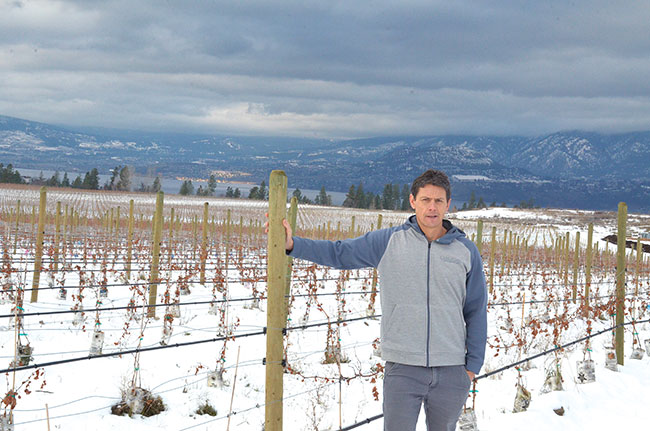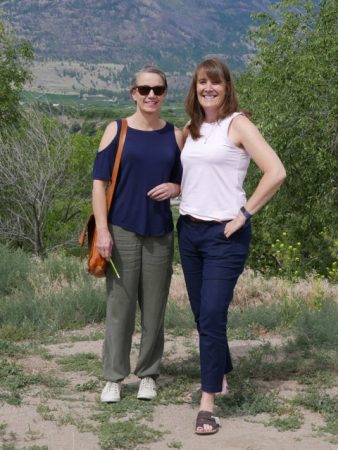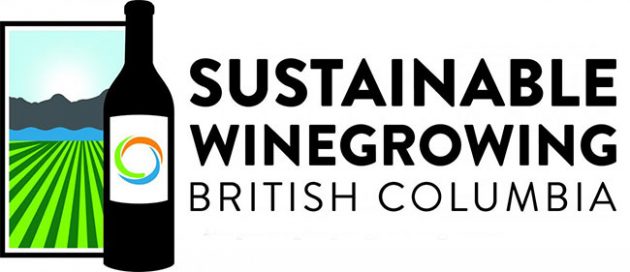
Features
Associations
Production
Certified sustainable winegrowing comes to B.C.
A third-party audit and certification process is available for B.C. vineyards and wineries in response to a growing consumer preference for sustainable practices.
March 10, 2020 By Tom Walker
 Chad Douglas, viticulturist for Quails’ Gate at their new 160-acre vineyard in southeast Kelowna, with a compost pile in the background. Photo courtesy of Tom Walker.
Chad Douglas, viticulturist for Quails’ Gate at their new 160-acre vineyard in southeast Kelowna, with a compost pile in the background. Photo courtesy of Tom Walker. In the spring of 2020, B.C. vineyards and wineries will be able to participate in a third-party audit and receive certification from Sustainable Winegrowing B.C. (SWBC). “It is the culmination of 12 years of work, since the B.C. Wine Grape Council (BCWGC) formed the first sustainability oversight committee in 2008,” says Katie Pease, SWBC program director.
The early work of the committee focused on defining and articulating objectives for the program. “I think that is what is unique about SWBC – that we are an industry-developed program,” Pease says. “It is very much by and about the people that are here and not adopted from somewhere else.” The BCWGC, funded by grower levies, provided some support, but the majority of the work has been done by volunteers, she notes.
“This is an opportunity to assist the wine industry here in B.C., to elevate their practice standards towards more regenerative agriculture,” Pease says. “It helps them identify their use and practices and then refine them.”
Pease says that the industry initiative coincides with consumer interest. “Increasingly we see a development of consumer preferences for sustainable practices,” Pease says. “We do think that our certification for wineries is most driven by that, as they will be the ones letting the consumer know.”

Katie Pease (left), SWBC program manager, with Severine Pinte, Le Vieux Pin Winery and LaStella Winery. Photo courtesy of Katie Pease.
“Our vision is to be good stewards of the land while enhancing the social and cultural value of the wine and grape industry, and improving its economic viability,” Pease says. “SWBC is not just about the environment. We have a triple bottom line approach that includes people, planet and profit.”
Vineyard sustainability goals include management of the watershed, soil, irrigation, integrated pest management (IPM) and social equity. Winery goals include water and energy efficiency, waste management, and climate action, as well as social equity.
The first four years of the initiative led to a series of self-assessment sustainability workbooks for Vineyard, Winery, and Winery Hospitality Services. By 2012 the assessments were online together with a management tool that provided an action plan template. The program focused on education and helping producers through the self-assessment. To date, 68 vineyards and 37 wineries have completed these programs.
There was a two-year gap when the program ran out of funding, but in 2015 it was back in business and looking ahead. “We had always had the goal of a certification program,” Pease says. “When I was hired, my job was to move towards that goal by taking the sustainability standards that had been developed for the guidebooks through to measurable outcomes that would form the basis of an audit process.”
They worked with ISEAL, a global membership organization for sustainability standards. “We wanted to develop outcomes with metrics that would back any of the claims around water savings, soil nutrition, carbon content, or energy savings,” Pease says. Those metrics allow participants to inform the improvements they can make, but also allow SWBC to start forming a picture of what sustainability looks like across the industry, she explains.
Pease says that data-driven outcomes are the ‘next wave’ in certification programs. “I feel that we are leading edge in launching something new-ish in the certification industry,” she says. “A lot of certification programs still don’t collect data, they work more from a laundry list of ‘to dos’.”
But consumers are becoming increasingly savvy and skeptical, Pease notes. “Organizations claim they are sustainable, but how can you back that up?”

In the spring of 2020, B.C. vineyards and wineries will be able to participate in a third-party audit and receive certification from Sustainable Winegrowing B.C.
Audit program pilot
This summer, SWBC ran a pilot audit program with four vineyard wineries. “It was a pretty soft audit,” quips Chad Douglas, viticulturist for Quail’s Gate, a large family-owned winery that emphasizes their sustainability practices. Douglas says the process involved a lot of dialogue about fulfilling the standards, and Pease says that’s what they want. “We are eager to have a friendly audit, a conversation about different opportunities.”
Severine Pinte, winemaker and viticulturist for Le Vieux Pin and Lastella Wineries, also took part in the pilot and admits that it was daunting at first. “I am strong on record-keeping and I have traceability, but a lot of it is either on my computer or in in my head,” she says. “My goal is to have it all in one binder.”
That is just one example of how certification can promote sustainability practices. “Certification is not an end goal where you stop – it is a path,” Pease says. “We have minimum critical criteria that must be met, but the overall goal is continuous improvement over time.”
Both Quail’s Gate and Le Vieux Pin have been key members of the SWBC committee, so they are familiar with the language of the outcomes. But Pinte says it is important to not get too bogged down in the process. “We all keep records of varying detail, and as a producer continues along the process it will get easier,” she says. “It is helping you to structure things, and in the end your business will get a lot easier.”
But Pinte says it is important to not get too bogged down in the process. “We all keep records of varying detail, and as a producer continues along the process it will get easier,” she says.
“What I like is that across the industry we are all going to be able to exchange practices and support each other to move forward,” Pinte says. “This is a very good instrument to bring the wine industry in the Okanagan to the next level.”
Pease says SWBC will offer certification audits starting in April of 2020. “The industry has told us that they want to get it done,” she says. They will be looking to train third-party auditors in the new year. There will be an all-in cost based on the size of an operation.
Resources to support producers in their on-going sustainability learning and implementation is important, Pease says. “But it is a challenge for us right now; we are launching this on a very shoestring budget,” she says. “We will be able to offer workshops throughout the year on topics such as water, soil, energy and waste, to help people monitor those things on their site.”
“We want to tell the story about the quality of B.C. wine,” Pease says. “And back that story by a standard that enhances the quality of the wine product, but also helps to maintain and enhance the quality of our environment.”
Producers can choose how they wish to add certification to their own story. “It can be a note on their label or a sign on their farm,” Pease says. “We will have our own campaign showcasing our product and our environment through the B.C. Wine Institute, but our members will do the best job at telling the story.”
Pinte elaborates, “When we receive certification and can communicate it to our customers that is good, but for me it is not the top priority. The top priority is to do my operation, my everyday work, with that sustainable factor in mind.”
Pinte elaborates, “When we receive certification and can communicate it to our customers that is good, but for me it is not the top priority. The top priority is to do my operation, my everyday work, with that sustainable factor in mind.” She says, “Being a better steward of the vineyard by practicing regenerative agriculture, or saving energy, managing waste water or retaining our people in the production side, that’s my story, and that speaks to the people who follow us.”
Print this page